I don’t know about you, but the fact that we’re a quarter into this century is blowing this marketer’s mind — especially since new marketing trends emerge with every flip of the calendar page.

In the last quarter century, we’ve seen the number of MarTech solutions grow from hundreds to tens of thousands.
![Download Now: Free State of Marketing Report [Updated for 2024]](https://no-cache.hubspot.com/cta/default/53/db725f24-564c-483b-a28c-2d6ff9986516.png)
Mobile became its own channel, ushering in an era of constant content consumption, and generative AI started unlocking efficiencies we had never imagined.
And that’s just a handful of the highlights.
The evolution continues, so let’s not waste time. Here are five new marketing trends we need to keep our eyes on in 2025, according to the 2025 State of Marketing Report (and how experts suggest you approach them).
1. Focusing On Younger Customers
Millennials and Gen Z are no longer just summer interns, people.
The oldest of the gens are in their early 40s and are the decision-makers, both professionally and personally.
The State of Marketing found that over the past twelve months, marketers (both B2C and B2B) have narrowed their focus to Gen Z and Millennial customers while pulling back on their attempts to reach Boomers and Gen X.
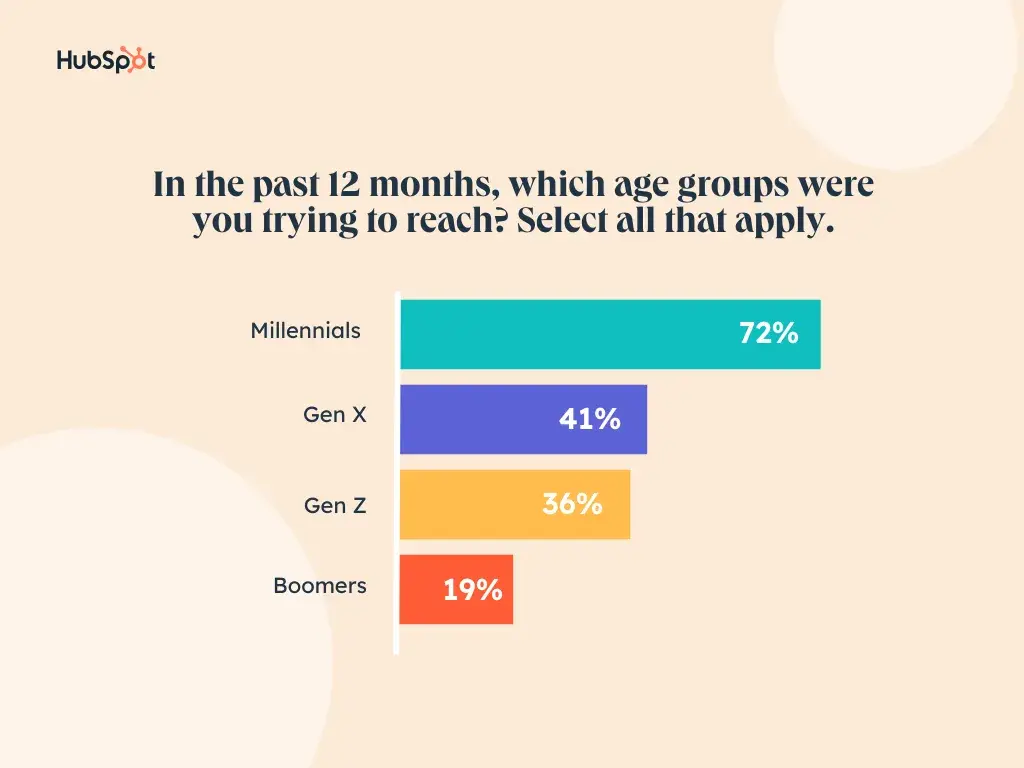
Head of Content at 6Minded, Joanna Borkowska, has seen and experienced this first-hand, sharing, “We’ve noticed it ourselves, collaborating more frequently with managers and founders born in the 90s, who now influence purchasing and strategy decisions.”
What does that mean for marketers?
“Marketers must revamp their tactics and prioritize personalization, networking, and authentic interactions,” advises Borkowska.
“While raised in the digital age, this generation craves genuine connections and trust built on shared experiences and goals. They seek partners who care and can truly understand them and grow and learn together.”
For brands of all kinds, this means delivering personalized, targeted content and insights based on your audience’s individual behaviors. It means catering your brand experience to the customer’s specific needs, showing you understand them.
Think sending emails with resources related to their past purchases (i.e. “How to get the most out of your [insert product purchased]”) or showing them articles similar to those they read in the past on your website.
You can also tap AI to help with personalization, like CEO at BridgeRev Ashley Quintana.
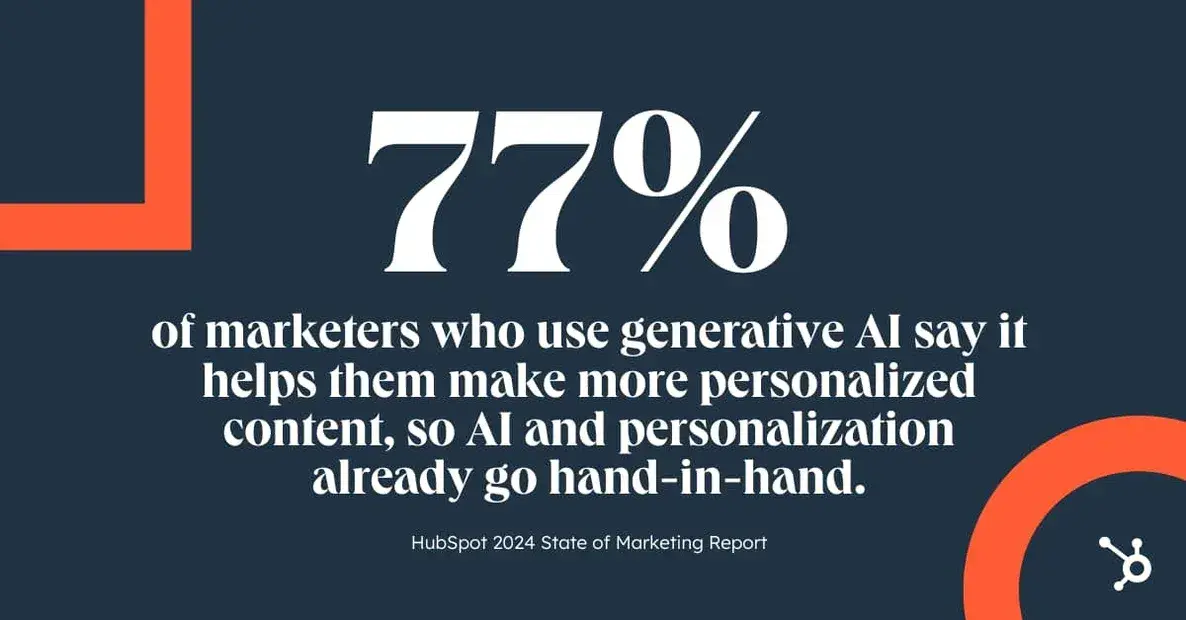
Source
“HubSpot’s AI tools like Breeze and Copilot have been invaluable. Breeze streamlines brainstorming and drafting, making it easy to create engaging, audience-specific content, while Copilot helps us optimize workflows by integrating AI directly into our daily tasks.”
“These tools allow us to deliver high-quality content faster without sacrificing the strategic and human elements our clients rely on.”
Check out:
- AI in Digital Marketing — The Complete Guide
- AI Marketing Automation: What Marketers Need to Know
- How to Use AI Personalization Tactics to Scale Marketing Growth
2. Leading with Brand
A bigger focus on personal and authentic consumer interactions also lends itself to another trend we’re seeing — brand-forward marketing.
We’re talking marketing focused on building brand awareness; strategies that really lean into the values, culture, and overall story of a business, rather than just its products or services.
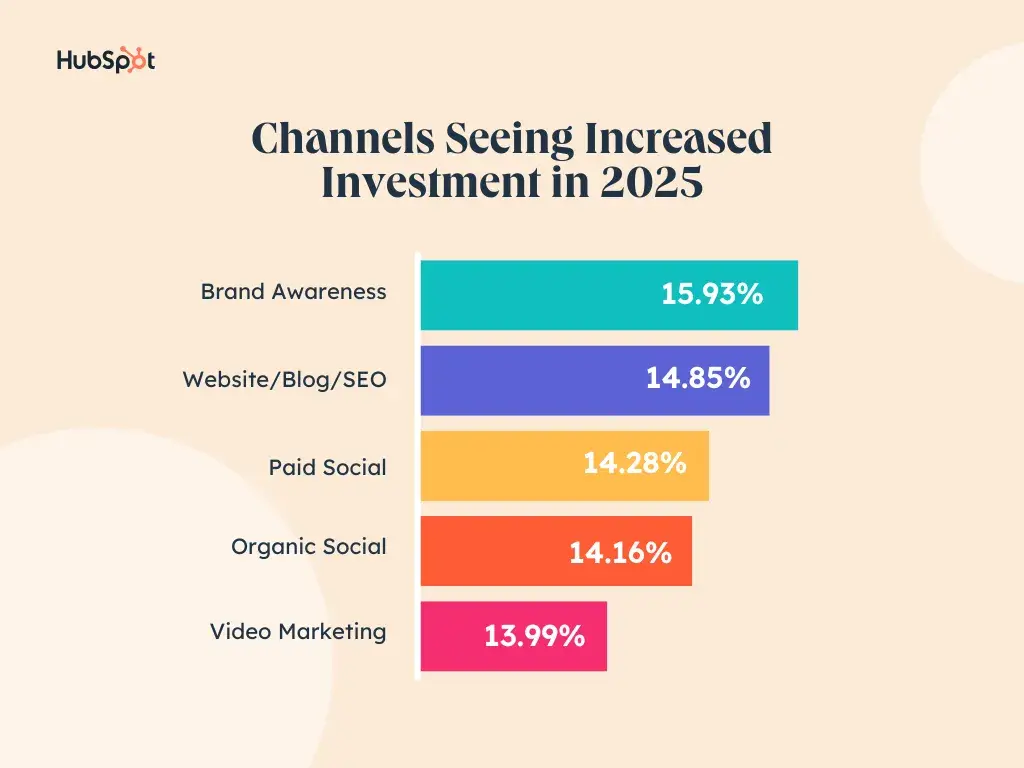
Brand was also a focus in 2024, but our research found many marketers plan to invest even more this year, especially in creating value-focused content.
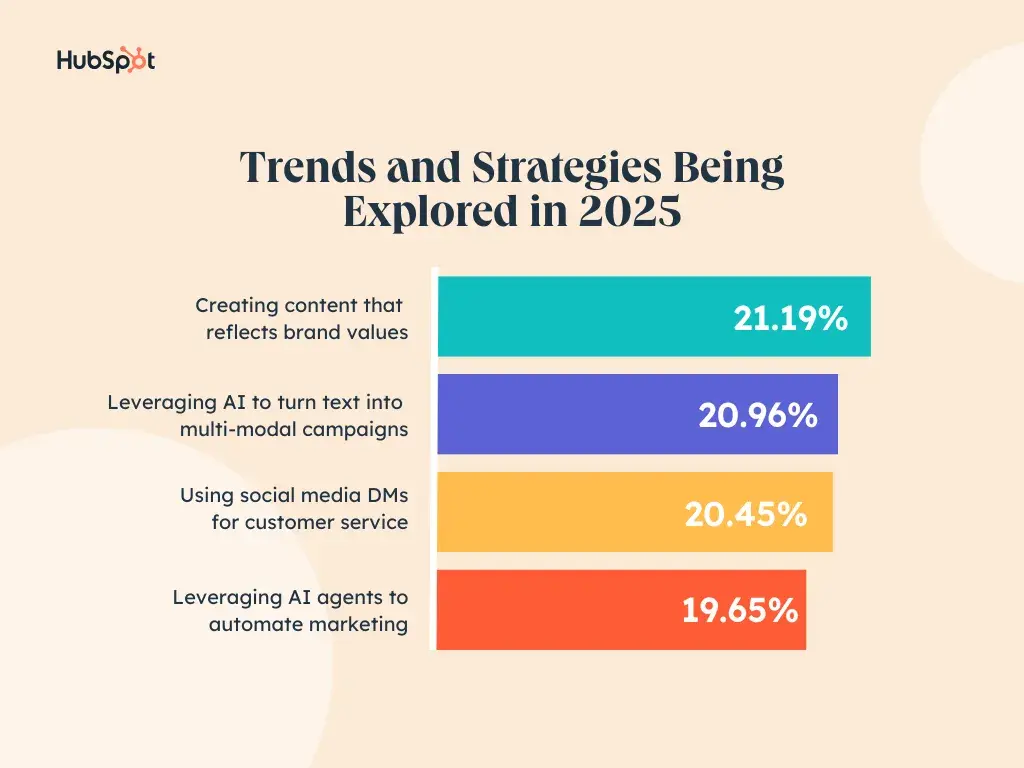
But why exactly?
Quintana explained, “The shift towards value-driven content reflects a broader demand for authenticity and trust in marketing. In 2025, consumers aren’t just choosing products or services — they’re aligning themselves with brands that resonate with their beliefs and reflect their values.”
In such socially charged times, people are shopping their values. They want to know that their hard-earned money is ultimately going to efforts, causes, and principles that they support on a deeper level.
Value-focused content is one way to make yours clear to buyers so they can join you or avoid.
What does that mean for marketers?
“For businesses looking to lead with their brand, my advice is simple: know your ‘why’ and weave it into every piece of content you create,“ continued Quintana. “Ensure that your actions align with the values you promote.”
One brand that does this well is Ben & Jerry’s. The ice cream company has made activism a staple of its brand since its founding in 1978.

Source
It highlights its values on its website and makes it a point to highlight its socially conscious business practices and the causes it cares about.
It’s also no stranger to advocating on social media about issues facing the world or incorporating them into their product names and marketing.
When you buy from Ben & Jerry’s, you know exactly what your dollars are going to on a greater level — and many consumers actually choose them because of that.
Pro tip: Use “Human Intelligence” to create your brand content.
Let’s be real: As more marketers incorporate AI into their writing processes, we’re seeing a rise in generic, low-quality content.
Continuing to create human-led content that isn’t simply copied and pasted from a chatbot is one way to stand out as a brand and ensure your values come through.
Even if you generate content with AI, make sure someone on your team takes the time to infuse your brand’s unique personality and tone of voice. Also, aim to add elements that reflect your brand’s specific values and culture, like original examples and first-hand experiences.
I mean, think about it. No one knows your culture and exudes your values better than those at your company. They have experiences, knowledge, and feelings AI never could. This is a big differentiator.
Want more tips on how to humanize your AI content? I’ve got you covered here.
3. Visuals as the Expectation
Short-form video, images, and live-streaming video were among the most commonly used content formats in 2024. Going into 2025, marketers are investing more in all three than in other mediums.
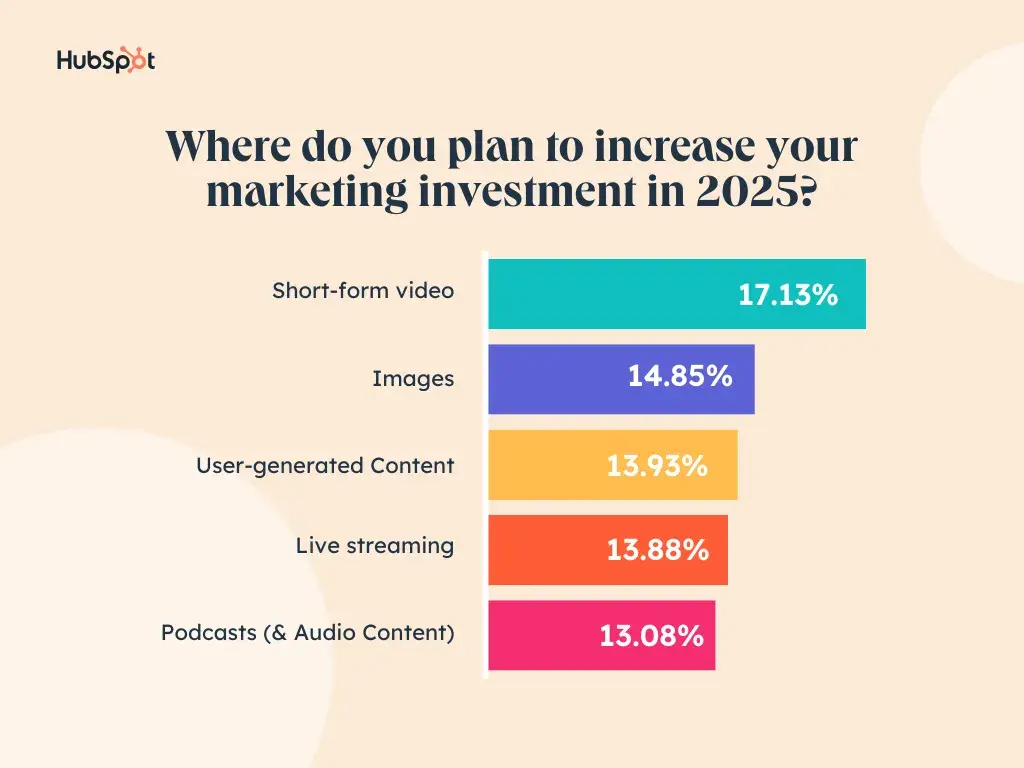
This makes sense. In 2024, all three formats were reported as having some of the highest ROIs.
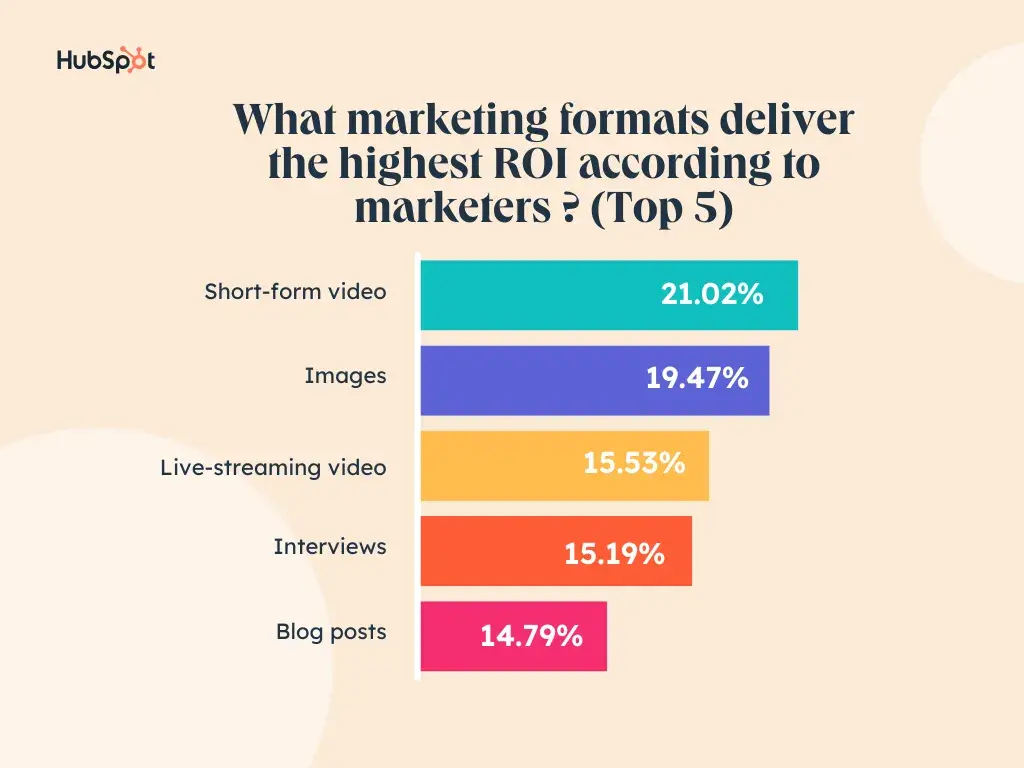
“Short-form video, images, and user-generated content resonate because they humanize brands and foster a deeper connection with audiences,” said Quintana, explaining the mediums’ popularity.
“They create opportunities for storytelling and amplify the voices of real customers, making marketing feel collaborative rather than transactional.”
However, much of this could simply be due to the prominence of social media. Every generation turns to social media to stay connected with their loved ones, learn, and consume content — and most of these platforms are visual.
If this is how your buyers spend time discovering products and brands, you’ve got to meet them there.
(Note: Because of this, marketers are also increasing their investment in YouTube, Instagram, and TikTok at rates higher than other channels in 2025.)
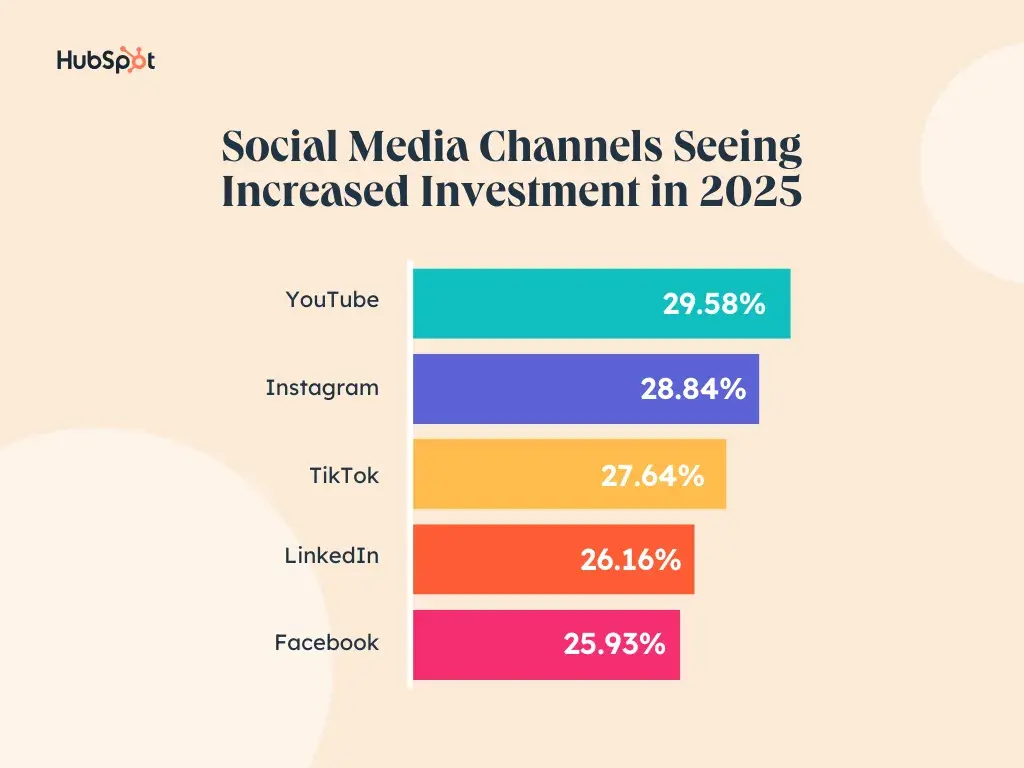
As reading attention spans plummet, video and audio take center stage. Audiences crave short, condensed, and authentic formats. For marketers, it’s a shift they cannot afford to ignore.
What does that mean for marketers?
Visual content is nothing new. In fact, the first article I ever wrote as a young marketer was about the power of visual marketing more than a decade ago.
But that doesn’t mean there’s nothing new to learn.
Dan Stillgoe, Senior Marketing Manager at Blend, recommends starting with repurposing.
“The key to starting is to start with a longer-form piece, like a podcast or event, that can then be chopped up into shorter-form video. This lowers the barrier to getting started.”
Joanna Borkowska reminds us to put our audiences first. “Start by researching what clicks with your audience and talking to your team.”
“Your people know your products and customers best. Brainstorm with them for fresh, real-life content ideas that resonate. Then, build assets and topics around those ideas, not the trending platforms.”
Lastly, Will Williamson, Director at JDR Group says we shouldn’t take our short-form videos too seriously.
“Ensure your videos are personal rather than corporate. The best-performing videos are going to be raw and authentic. Get your people talking as real humans!“
4. Tapping Into Niche Influence
With a shift to brand-led strategies and younger audiences, the emergence of influencer marketing makes sense, but any old influencer won’t cut it anymore.
In 2025, marketers are seeing more success with small influencers (those with fewer than 100,000 followers). And I’m not surprised.
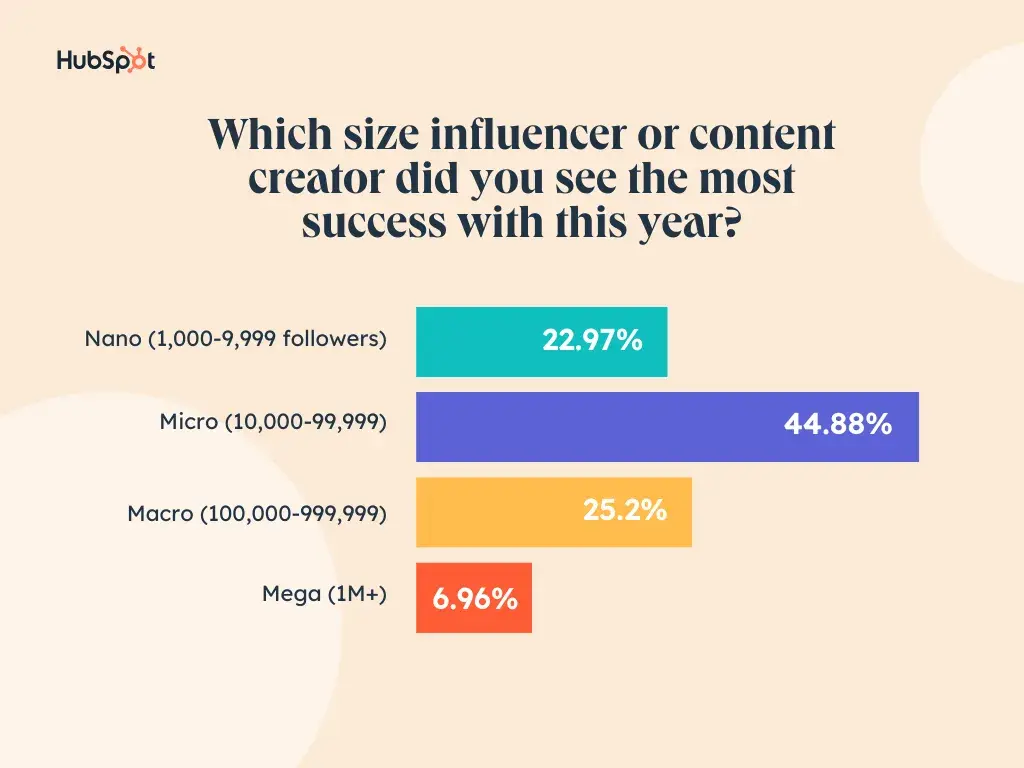
Back in the day — read two to five years ago — the deep-rooted trust and loyalty marketers vie for with influencer marketing was easier to come by. Followers could enjoy and expect personal interactions with the creators they loved.
Heck, I remember when Jay Shetty promised to respond to every comment within 24-48 hours (and he did).
However, as “influencers” and “creators” have become more established professions and follower numbers reach the millions, the sense of connection consumers flocked to isn’t as common — at least not with “mega” influencers like Jay.
Thankfully, the audiences of nano, micro, and macro influencers are still small and mighty, delivering the credibility, community, engagement, and cost-effectiveness that marketers crave.
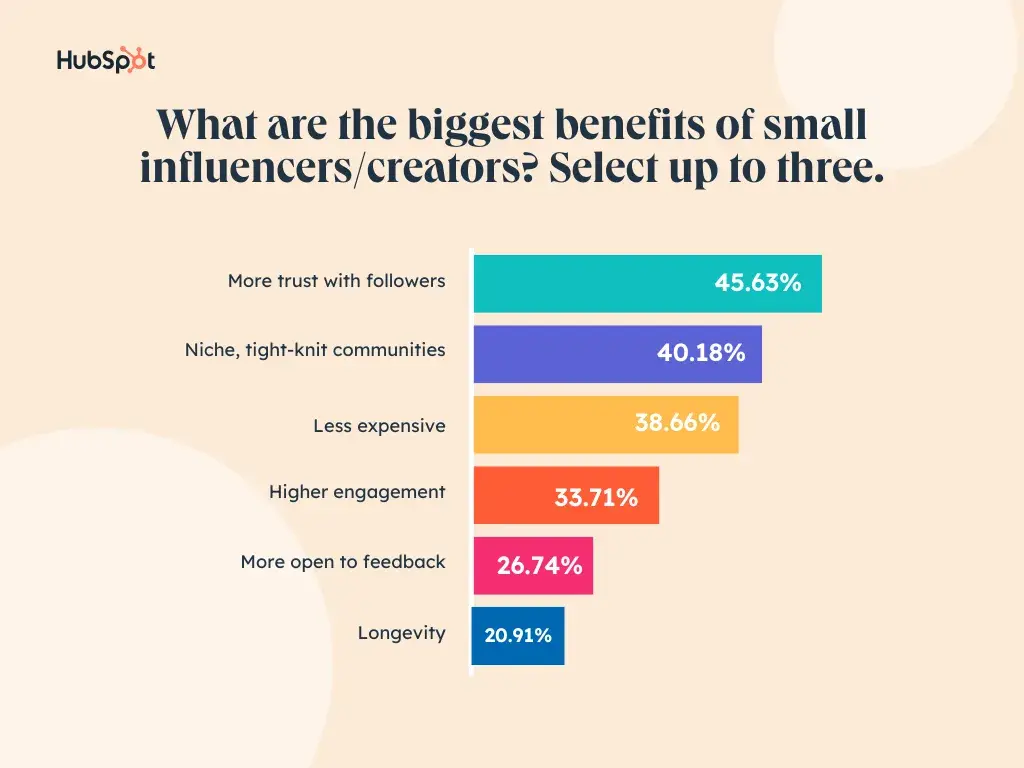
What does that mean for marketers?
In 2025, marketers need to get more niche with their influencer marketing.
Don’t just go after people with large audiences, but those whose audience would actually buy your brand and product. Also, look for influencers with credibility and insight into what you do and offer.
“People who are experts in something are inherently more trustworthy than a generic Google AI Overview or basic interpretation by ChatGPT,” explains Paul Mortimer, Head of Marketing at Avidly.
Like, if you’re a skincare brand, it may be cool to have YouTube chef “Binging with Babish” talk about your products, but he doesn’t really have expertise in your industry. (At least as far as we know.)
Check out our article. “How to Identify & Work With the Best Brand Influencers for Your Business” for more guidance on how to find the right niche influencers to achieve your goals.
5. Using AI to keep up with content needs
In 2024, all people could talk about was using AI to write content, but its capabilities are far greater than just text, and honestly, the other use cases are much stronger.
For example, AI can repurpose content into new formats faster than ever — including visual ones. Blogs can be turned into video scripts and text into images, gifs, or video clips.
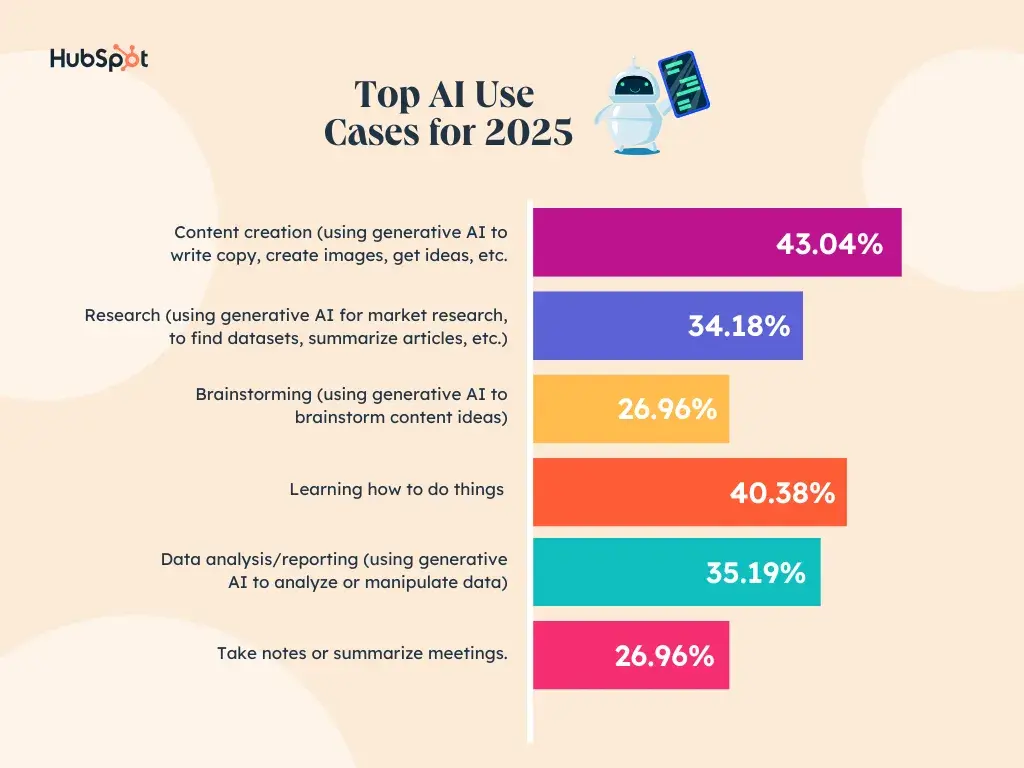
Of course, this shift isn’t without its challenges. Our survey found nearly half of all marketers are unsure of their ability to use AI effectively and measure the ROI of using AI to assist their marketing efforts.
What does that mean for marketers?
With AI becoming a part of everyday life, Ryan Gunn, Director of Demand Gen & Marketing Ops at Aptitude 8 warns that companies will expect more from smaller teams, especially when it comes to diversifying mediums or personalizing content for a specific audience.
But its effectiveness hinges on clean, well-structured data.
“As businesses ramp up segmentation and personalization, syncing accurate data across systems will be the key to unlocking AI’s full potential,” Gunn continued. “The better your data, the smarter your AI-powered marketing becomes, and the easier it is to hit your goals.”
That said, make sure to keep your data clean. Tools like HubSpot’s Breeze Co-Pilot make this easy by connecting your CRM data across all your business efforts, but there’s plenty you can do manually as well.
- Remove duplicate information.
- Correct structural errors.
- Address missing data.
- Regularly update and sync data.
- Standardize data entry.
All of these precautions will make your data easier for AI to understand and utilize, whether generating new content or offering strategic insights.
How else are marketers using AI day-to-day? Check out the trends and insights from a survey of over 1,000 marketers.
Evolve and Elevate in 2025
Success in this dynamic era will depend on your ability to evolve, innovate, and stay authentic. The key takeaway? Stay human. While technology and trends will continue to shape our strategies, the brands that stand out will be the ones that genuinely understand and resonate with their audiences.
So, as you map out your marketing plans for the year ahead, remember: it’s not just about keeping up with the latest trends — it’s about using them as tools to build deeper, more meaningful connections with the people you serve.
Editor’s Note: This post was originally published in December 2020 and has been updated annually to include new, exclusive HubSpot data and expert insights.
![5 New Marketing Trends To Watch in 2025 [Backed by Data & a Dash of Expert Wisdom]](http://blog.contentkrush.com/wp-content/uploads/2021/06/cropped-ck1.png)

![5 New Marketing Trends To Watch in 2025 [Backed by Data & a Dash of Expert Wisdom] 5 New Marketing Trends To Watch in 2025 [Backed by Data & a Dash of Expert Wisdom]](https://accesspressthemes.com/import/vmagazine/wp-content/uploads/2018/05/u7-adss.jpg)


![Holistic Marketing Works — Here’s How You Can Apply It to Your Campaigns [+ Expert Tips] holistic-marketing-works-—-here’s-how-you-can-apply-it-to-your-campaigns-[+-expert-tips]](https://blog.contentkrush.com/wp-content/uploads/2024/11/140539-holistic-marketing-works-heres-how-you-can-apply-it-to-your-campaigns-expert-tips-510x369.webp)
![What is B2C Marketing? [+ New Data & Trends to Captivate Audiences in 2025] what-is-b2c-marketing?-[+-new-data-&-trends-to-captivate-audiences-in-2025]](https://blog.contentkrush.com/wp-content/uploads/2025/01/140852-what-is-b2c-marketing-new-data-trends-to-captivate-audiences-in-2025-510x369.jpg)

![5 Steps to Create an Outstanding Marketing Plan [Free Templates] 5-steps-to-create-an-outstanding-marketing-plan-[free-templates]](https://blog.contentkrush.com/wp-content/uploads/2024/08/140066-5-steps-to-create-an-outstanding-marketing-plan-free-templates-510x369.png)
![How B2C Companies Leverage AI Marketing [Examples & Tips] how-b2c-companies-leverage-ai-marketing-[examples-&-tips]](https://blog.contentkrush.com/wp-content/uploads/2024/12/140611-how-b2c-companies-leverage-ai-marketing-examples-tips-510x369.webp)

![The Top Goals of Marketing Managers & Leaders in 2025 [New Data + Expert Tips] the-top-goals-of-marketing-managers-&-leaders-in-2025-[new-data-+-expert-tips]](https://blog.contentkrush.com/wp-content/uploads/2024/11/140581-the-top-goals-of-marketing-managers-leaders-in-2025-new-data-expert-tips-510x369.webp)
![5 Marketing Trends That Might Not Survive in 2024 [HubSpot Research + Expert Insights] 5-marketing-trends-that-might-not-survive-in-2024-[hubspot-research-+-expert-insights]](https://blog.contentkrush.com/wp-content/uploads/2024/03/129681-5-marketing-trends-that-might-not-survive-in-2024-hubspot-research-expert-insights-510x369.jpg)





![How to Create a Complete Marketing Strategy in 2025 [Data + Expert Tips] how-to-create-a-complete-marketing-strategy-in-2025-[data-+-expert-tips]](https://blog.contentkrush.com/wp-content/uploads/2024/10/140338-how-to-create-a-complete-marketing-strategy-in-2025-data-expert-tips-510x369.webp)


![What Is D2C Marketing? Here Are 11 Tips I Found For Doing It Right [+ Examples] what-is-d2c-marketing?-here-are-11-tips-i-found-for-doing-it-right-[+-examples]](https://blog.contentkrush.com/wp-content/uploads/2024/11/140459-what-is-d2c-marketing-here-are-11-tips-i-found-for-doing-it-right-examples-510x369.webp)

![Sustainable Marketing: Key Principles & How to Leverage It [+ Examples] sustainable-marketing:-key-principles-&-how-to-leverage-it-[+-examples]](https://blog.contentkrush.com/wp-content/uploads/2024/10/140354-sustainable-marketing-key-principles-how-to-leverage-it-examples-510x369.jpg)









Comment here